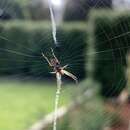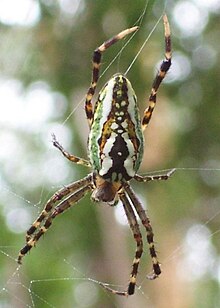en
names in breadcrumbs


Plebs is a genus of orb-weaver spiders first described by M. M. Joseph & V. W. Framenau in 2012.[2] Though many of its species have been moved around, a 2012 taxonomic revision suggested that these spiders comprise a monophyletic genus of closely related spiders that evolved in Australia and, through subsequent movements, spread into parts of Asia and Pacific islands.[2]
"Plebs" is Latin for "common people" and refers to this genus being common in Australia.[2]
Plebs can be recognised by the unique pattern on the underside of the abdomen: a light inverted U shape, followed by two light spots anterolateral to the spinnerets. Spiders of this genus have a typical "eriophorine" genital morphology: the male pedipalp has a paramedian apophysis and an elongated transverse median apophysis, while the female epigyne has an elongated scape without terminal pockets.[2]
These spiders are mainly diurnal, unlike most Araneinae which are mainly nocturnal. They build regular orb-webs with vertical stabilimenta (web decorations used by this and other diurnal orb-weavers). Their webs are generally built in grass and low shrubs.[2]
As of April 2019 it contains twenty-two species. Seven are found in Australia, thirteen in Asia, one on New Caledonia, and one endemic to Vanuatu.[1]
 Plebs bradleyi
Plebs bradleyi Plebs is a genus of orb-weaver spiders first described by M. M. Joseph & V. W. Framenau in 2012. Though many of its species have been moved around, a 2012 taxonomic revision suggested that these spiders comprise a monophyletic genus of closely related spiders that evolved in Australia and, through subsequent movements, spread into parts of Asia and Pacific islands.